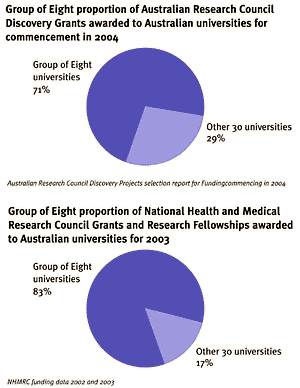 Whither
the Universities -- Simon Marginson Gives His Summing-up. (Match 28, 2005)
Whither
the Universities -- Simon Marginson Gives His Summing-up. (Match 28, 2005)
|
News & Views item - March 2005 |
![]()

Today, in something under 900 words, the director of the Monash Centre for Research in International Education, Simon Marginson has given in The Age his assessment of where the Minister for Education Science and Training, Brendan Nelson, is steering Australia's universities. Among his many publications his book with Mark Considine, The enterprise university: Power, governance and reinvention in Australia credentials him.
Marginson sees Dr Nelson's reformation as creating a shake-up of the Australian
university system as great as, if not greater than, that wrought through
Dawkinsisation. But in fact what Marginson appears to be describing is a partial counter revolution which
involves undoing the John Dawkins' homogenisation of the universities and that
this will be attempted through a redistribution of federal research funding by
means of a system similar to Britain's Research Assessment Exercise. But in fact
as the Group of Eight has repeatedly pointed out the majority of research
funding distributed to the universities already goes to a small minority of
Australia's public universities. The result wrought by DR Nelson will be at best
a marginal improvement of research resources for current major Australian
research schools, and when coupled with the federal government's increasing
research prioritisation and micromanagement, it can easily be argued that by
world standards Australia could well be left struggling as suggested recently by
Sir Gareth Roberts.
Marginson appears to be describing is a partial counter revolution which
involves undoing the John Dawkins' homogenisation of the universities and that
this will be attempted through a redistribution of federal research funding by
means of a system similar to Britain's Research Assessment Exercise. But in fact
as the Group of Eight has repeatedly pointed out the majority of research
funding distributed to the universities already goes to a small minority of
Australia's public universities. The result wrought by DR Nelson will be at best
a marginal improvement of research resources for current major Australian
research schools, and when coupled with the federal government's increasing
research prioritisation and micromanagement, it can easily be argued that by
world standards Australia could well be left struggling as suggested recently by
Sir Gareth Roberts.
So although the Nelsonisation of the universities may lead to a reduction of significant university research, it wouldn't be because of a redistribution of research funding but rather a continuing systematic starvation of resources.
On the other hand Professor Marginson sees clearly that the government's manipulating of student tuition has as its principle aim "a unified full-fee student market."
[T]he Government can draw together full-fee and HECS strands by lifting the limits on maximum HECS, FEE-HELP places and FEE-HELP debt, and reconfiguring the publicly subsidised HECS places as merit scholarships. Presto! A unified full-fee student market.
Marginson does warn that there are caveats associated with the FEE-HELP scheme.
The long-term costs of FEE-HELP might be unsustainable. The Government carries the costs of the sub-commercial interest regime, and incomplete repayment or default. Many graduates won't earn enough over their lifetimes to repay all of their debts, and others will go overseas. Meanwhile, though, FEE-HELP is transforming the sector.
Entry scores for full-fee places are below HECS places. Those students unable to secure their optimum HECS place (i.e. most students) can secure their preferred course/ university with FEE-HELP assistance by going deeper into debt.
But that would be a future government's problem and really would require nothing more than a subsequent "squeeze-play".
While it may well be that the lesser universities will become diminished, those higher in the pecking order will not be significantly improved because of it.